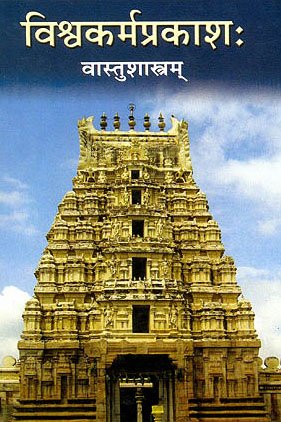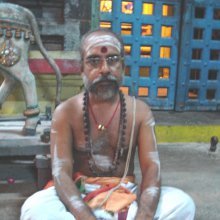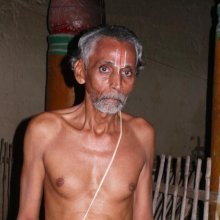Palli, Pallī: 18 definitions
Introduction:
Palli means something in Hinduism, Sanskrit, the history of ancient India, Marathi, Jainism, Prakrit, Hindi, Tamil. If you want to know the exact meaning, history, etymology or English translation of this term then check out the descriptions on this page. Add your comment or reference to a book if you want to contribute to this summary article.
Images (photo gallery)
In Hinduism
Vastushastra (architecture)
Source: archive.org: Personal and geographical names in the Gupta inscriptions (vastu)Pallī (पल्ली).—The Samarāṅgaṇasūtradhāra 1.18.6 by king Bhojadeva, an eleventh century work, defines Pallī thus: “Where Pulindas live building their huts with leafs, branches and stones etc. is called Pallī and a small Pallī is called Pallīkā”.

Vastushastra (वास्तुशास्त्र, vāstuśāstra) refers to the ancient Indian science (shastra) of architecture (vastu), dealing with topics such architecture, sculpture, town-building, fort building and various other constructions. Vastu also deals with the philosophy of the architectural relation with the cosmic universe.
Shaktism (Shakta philosophy)
Source: Google Books: ManthanabhairavatantramPalli (पल्लि) or Pallī refers to “villages”, according to the Manthānabhairavatantra, a vast sprawling work that belongs to a corpus of Tantric texts concerned with the worship of the goddess Kubjikā.—Accordingly, “[...] Prabhu, Yogin, Ānanda, Āvalī, Ātīta, Pāda, and the rest called Kulas (are) all (like) rivers that fall into the root transmission. They, the princes and the gods, bodies, forests, villages (palli), houses and others that are born from the root (transmission) are like rivers (that flow) from the mountain of Kula”.

Shakta (शाक्त, śākta) or Shaktism (śāktism) represents a tradition of Hinduism where the Goddess (Devi) is revered and worshipped. Shakta literature includes a range of scriptures, including various Agamas and Tantras, although its roots may be traced back to the Vedas.
India history and geography
Source: archive.org: Personal and geographical names in the Gupta inscriptionsPallī (पल्ली) refers to a name-ending for place-names mentioned in the Gupta inscriptions (reigned from 3rd century CE). The suffix—palli, pallī, pallaka or its diminutive pallikā is derived from √ pal to go, to move. It means a small village, (esp.) a settlement of wild tribes (e.g. Triśira-pallī = Trichinopoly). Pallī has been used as meaning a den of thieves in the Uttarādhyanasūtra and other Jain canonical texts, the earliest portions of which are assigned to about 300 B.C.
Pallī is changed into:
- bal, Āśāpallī, Yessabal
- poli, as Triśirapallī (= Trishṇāpallī), Trichinopoly
- oli, as Ahalyapallī, Ahiroli (also Ahiāri).
Pallī.—(IE 8-4; EI 23), ‘a hamlet’; ‘a village or its part’; often suffixed to the names of localities. Note: pallī is defined in the “Indian epigraphical glossary” as it can be found on ancient inscriptions commonly written in Sanskrit, Prakrit or Dravidian languages.
--- OR ---
Paḻḻi.—(SII 1, 2; SITI), Tamil; often, a Jain temple; the shrine of non-Hindu communities like the Jains, Buddhists, Christians, Muhammadans, etc.; cf. paḻḻi-ccandam, temple land; paḻḻi-grāma, a village belonging to a temple. Note: paḻḻi is defined in the “Indian epigraphical glossary” as it can be found on ancient inscriptions commonly written in Sanskrit, Prakrit or Dravidian languages.
Source: Singhi Jain Series: Ratnaprabha-suri’s Kuvalayamala-katha (history)Pallī (पल्ली) refers to an ancient forest settlement, according to Uddyotanasūri in his 8th-century Kuvalayamālā (a Prakrit Campū, similar to Kāvya poetry).—The Kuvalayamala (779 A.D.) is full of cultural material which gains in value because of the firm date of its composition. [...] Page 62.5: There is a reference of Pallī, which was a forest settlement, and to its Śabara chief, the description being partly modelled after Bāṇa’s Harṣacarita.

The history of India traces the identification of countries, villages, towns and other regions of India, as well as mythology, zoology, royal dynasties, rulers, tribes, local festivities and traditions and regional languages. Ancient India enjoyed religious freedom and encourages the path of Dharma, a concept common to Buddhism, Hinduism, and Jainism.
Languages of India and abroad
Marathi-English dictionary
Source: DDSA: The Molesworth Marathi and English Dictionarypalli (पल्लि).—f S The house-lizard. Popularly pāla.
Source: DDSA: The Aryabhusan school dictionary, Marathi-Englishpalli (पल्लि).—f The house-lizard. Popularly pāla.
Marathi is an Indo-European language having over 70 million native speakers people in (predominantly) Maharashtra India. Marathi, like many other Indo-Aryan languages, evolved from early forms of Prakrit, which itself is a subset of Sanskrit, one of the most ancient languages of the world.
Sanskrit dictionary
Source: DDSA: The practical Sanskrit-English dictionaryPalli (पल्लि) or Pallī (पल्ली).—f.
1) A small village; पल्लीघोषान् समृद्धांश्च बहुगोकुलसंकुलान् (pallīghoṣān samṛddhāṃśca bahugokulasaṃkulān) (apaśyat) Mahābhārata (Bombay) 12.325.2; also a settlement of wild tribes.
2) A hut.
3) A house, station.
4) A city or town (at the end of names of towns); as त्रिशिर- पल्ली (triśira- pallī) (Trichinopoly).
5) A house-lizard.
6) A creeping-plant.
Derivable forms: palliḥ (पल्लिः).
Source: Cologne Digital Sanskrit Dictionaries: Shabda-Sagara Sanskrit-English DictionaryPalli (पल्लि).—f.
(-lliḥ) 1. A small village. 2. Any village. 3. A house. 4. A number of houses. 5. Any place or station. 6. A house-lizard: see palla.
Palli can also be spelled as Pallī (पल्ली).
Source: Cologne Digital Sanskrit Dictionaries: Cappeller Sanskrit-English DictionaryPalli (पल्लि).—[feminine] a small village, [especially] a settlement of wild tribes.
Source: Cologne Digital Sanskrit Dictionaries: Monier-Williams Sanskrit-English Dictionary1) Pallī (पल्ली):—[from palla > pall] a f. See below.
2) Palli (पल्लि):—[from pall] a f. a small village, ([especially]) a settlement of wild tribes, [cf. Lexicographers, esp. such as amarasiṃha, halāyudha, hemacandra, etc.]
3) [v.s. ...] a hut, house, [ib.]
4) Pallī (पल्ली):—[from pall] b f. a small village etc. (= palli), [Kathāsaritsāgara]
5) [v.s. ...] a hut, house, [cf. Lexicographers, esp. such as amarasiṃha, halāyudha, hemacandra, etc.]
6) [v.s. ...] a city ([especially] ifc., in Name of towns e.g. triśira-p, = Trichinopoly)
7) [v.s. ...] a [particular] measure of grain, [Kātyāyana-śrauta-sūtra [Scholiast or Commentator]]
8) [v.s. ...] a small house-lizard, [cf. Lexicographers, esp. such as amarasiṃha, halāyudha, hemacandra, etc.]
9) Palli (पल्लि):—b pallī See under √pall.
Source: Cologne Digital Sanskrit Dictionaries: Yates Sanskrit-English DictionaryPalli (पल्लि):—(lliḥ) 2. f. A small village; a house; a place; a house lizard.
Source: DDSA: Paia-sadda-mahannavo; a comprehensive Prakrit Hindi dictionary (S)Palli (पल्लि) in the Sanskrit language is related to the Prakrit word: Palli.
[Sanskrit to German]
Sanskrit, also spelled संस्कृतम् (saṃskṛtam), is an ancient language of India commonly seen as the grandmother of the Indo-European language family (even English!). Closely allied with Prakrit and Pali, Sanskrit is more exhaustive in both grammar and terms and has the most extensive collection of literature in the world, greatly surpassing its sister-languages Greek and Latin.
Hindi dictionary
Source: DDSA: A practical Hindi-English dictionaryPallī (पल्ली):—(nf) a village; hamlet; see [paralī] (under [paralā]).
...
Prakrit-English dictionary
Source: DDSA: Paia-sadda-mahannavo; a comprehensive Prakrit Hindi dictionaryPalli (पल्लि) in the Prakrit language is related to the Sanskrit word: Palli.
Prakrit is an ancient language closely associated with both Pali and Sanskrit. Jain literature is often composed in this language or sub-dialects, such as the Agamas and their commentaries which are written in Ardhamagadhi and Maharashtri Prakrit. The earliest extant texts can be dated to as early as the 4th century BCE although core portions might be older.
Kannada-English dictionary
Source: Alar: Kannada-English corpusPalli (ಪಲ್ಲಿ):—[noun] the house lizard.
--- OR ---
Palli (ಪಲ್ಲಿ):—
1) [noun] a group of houses in the country, larger than a hamlet and smaller than a city or town; a village.
2) [noun] a place or building to live in.
3) [noun] a kind of creeper.
--- OR ---
Paḷḷi (ಪಳ್ಳಿ):—
1) [noun] a group of houses in a rural area, larger than a hamlet and usu. smaller than a town; a village.
2) [noun] a settling of oneself as a dweller permanently or for a considerably long time.
--- OR ---
Paḷḷi (ಪಳ್ಳಿ):—[noun] (dial.) a kind of game played by boys in which two boys hold each other’s left hand firmly and the third boy tries to unlock the hold.
Kannada is a Dravidian language (as opposed to the Indo-European language family) mainly spoken in the southwestern region of India.
See also (Relevant definitions)
Starts with (+101): Pal-irucurappu, Pal-irukatti, Palli Veedu, Palli Veedu, Palli-cchanda, Palli-deva, Palli-eluccimuracam, Palli-kampuvai, Palli-kutattutampi, Palli-ppuntu, Palli-soppu, Pallicai, Palliccanar, Palliccantam, Pallicceti, Pallid milkweed, Pallid service berry, Pallidesha, Palliga, Palligi.
Ends with (+52): Abhirapalli, Acivakappalli, Ahalyapalli, Aksharapalli, Amtarapalli, Ankapalli, Aravorpalli, Ashapalli, Aticirpalli, Bemgapalli, Bepalli, Bhillapalli, Billapalli, Canka-mataipalli, Cerkkaippalli, Cheriyoor Mullapalli, Cheriyoor Mullapalli, Ciraippalli, Cirappalli, Erandapalli.
Full-text (+205): Abhirapalli, Palla, Pallika, Pallittolan, Palli-cchanda, Pallikkutam, Pallivalar, Pallaka, Pallikkunru, Palliyotam, Tiru-pallikattil, Palliyampalam, Palliyarai, Matalaippalli, Pallisharatayohshanti, Pallisharatavidhana, Pallipatanakarika, Pallisharatakakabhasadishakuna, Pallipatanaphala, Pallipatanavicara.
Relevant text
Search found 22 books and stories containing Palli, Pallī, Paḻḻi, Paḷḷi; (plurals include: Pallis, Pallīs, Paḻḻis, Paḷḷis). You can also click to the full overview containing English textual excerpts. Below are direct links for the most relevant articles:
Middle Chola Temples (by S. R. Balasubrahmanyam)
Temples in Nagapattinam < [Chapter II - Temples of Rajaraja I’s Time]
Temples in Chakrapalli (Suburb of Ayyampettai) < [Parantaka I]
Bhakti-rasamrta-sindhu (by Śrīla Rūpa Gosvāmī)
Verse 4.5.4 < [Part 5 - Anger (raudra-rasa)]
Harshacharita (socio-cultural Study) (by Mrs. Nandita Sarmah)
Part 3: Description of Different Tribes and Sub-Castes < [Chapter 2 - Caste System]
Part 2.4: Relationship with the Sovereign Kings < [Chapter 5 - Political Aspects]
Part 6: Administration and Administrative Officials < [Chapter 5 - Political Aspects]
Maala Palli < [October – December, 1979]
I Counted Coins with Rajaji < [January – March, 1979]
Dr. Ananda Coomaraswamy as an Interpreter of < [July – September, 1994]
Early Chola Temples (by S. R. Balasubrahmanyam)
Temples in Tirukkuruhavur < [Chapter VIII - Temples of Uttama Chola’s Time]
Inscriptional References < [Chapter V - Aditya II]
Temples In Punjai < [Chapter X - Historical Survey]
Tiruvaymoli (Thiruvaimozhi): English translation (by S. Satyamurthi Ayyangar)
Pasuram 2.2.7 < [Section 2 - Second Tiruvaymoli (Tinnan vitu)]
Pasuram 4.1.5 < [Section 1 - First Tiruvaymoli (Oru nayakamay)]
Pasuram 6.6.5 < [Section 6 - Sixth Tiruvaymoli (Malukku, vaiyam alanta)]

